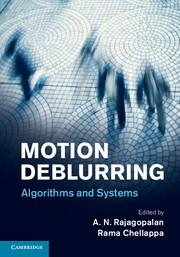Book contents
- Frontmatter
- Contents
- List of contributors
- Preface
- 1 Mathematical models and practical solvers for uniform motion deblurring
- 2 Spatially-varying image deblurring
- 3 Hybrid-imaging for motion deblurring
- 4 Efficient, blind, spatially-variant deblurring for shaken images
- 5 Removing camera shake in smartphones without hardware stabilization
- 6 Multi-sensor fusion for motion deblurring
- 7 Motion deblurring using fluttered shutter
- 8 Richardson–Lucy deblurring for scenes under a projective motion path
- 9 HDR imaging in the presence of motion blur
- 10 Compressive video sensing to tackle motion blur
- 11 Coded exposure motion deblurring for recognition
- 12 Direct recognition of motion-blurred faces
- 13 Performance limits for motion deblurring cameras
- Index
- References
4 - Efficient, blind, spatially-variant deblurring for shaken images
Published online by Cambridge University Press: 05 June 2014
- Frontmatter
- Contents
- List of contributors
- Preface
- 1 Mathematical models and practical solvers for uniform motion deblurring
- 2 Spatially-varying image deblurring
- 3 Hybrid-imaging for motion deblurring
- 4 Efficient, blind, spatially-variant deblurring for shaken images
- 5 Removing camera shake in smartphones without hardware stabilization
- 6 Multi-sensor fusion for motion deblurring
- 7 Motion deblurring using fluttered shutter
- 8 Richardson–Lucy deblurring for scenes under a projective motion path
- 9 HDR imaging in the presence of motion blur
- 10 Compressive video sensing to tackle motion blur
- 11 Coded exposure motion deblurring for recognition
- 12 Direct recognition of motion-blurred faces
- 13 Performance limits for motion deblurring cameras
- Index
- References
Summary
In this chapter we discuss modelling and removing spatially-variant blur from photographs. We describe a compact global parameterization of camera-shake blur, based on the 3D rotation of the camera during the exposure. Our model uses three-parameter homographies to connect camera motion to image motion and, by assigning weights to a set of these homographies, can be seen as a generalization of the standard, spatially-invariant convolutional model of image blur. As such we show how existing algorithms, designed for spatially-invariant deblurring, can be ‘upgraded’ in a straightforward manner to handle spatially-variant blur instead. We demonstrate this with algorithms working on real images, showing results for blind estimation of blur parameters from single images, followed by non-blind image restoration using these parameters. Finally, we introduce an efficient approximation to the global model, which significantly reduces the computational cost of modelling the spatially-variant blur. By approximating the blur as locally-uniform, we can take advantage of fast Fourier-domain convolution and deconvolution, reducing the time required for blind deblurring by an order of magnitude.
Introduction
Everybody is familiar with camera shake, since the resulting blur spoils many photos taken in low-light conditions. Camera-shake blur is caused by motion of the camera during the exposure; while the shutter is open, the camera passes through a sequence of different poses, each of which gives a different view of the scene. The sensor accumulates all of these views, summing them up to form the recorded image, which is blurred as a result. We would like to be able to deblur such images to recover the underlying sharp image, which we would have captured if the camera had not moved.
- Type
- Chapter
- Information
- Motion DeblurringAlgorithms and Systems, pp. 75 - 99Publisher: Cambridge University PressPrint publication year: 2014



